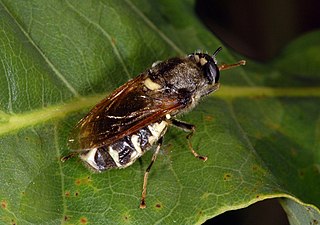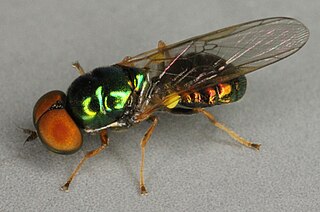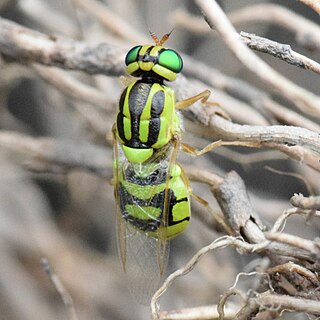
Besseria is a genus of flies in the family Tachinidae.
Melanostolus is a genus of flies in the family Dolichopodidae. It includes six species, which are distributed in Europe and Asia.

Empis is a genus of dance fly found in the fly family Empididae.

Oplodontha viridula, the common green colonel, is a European species of soldier fly.

Odontomyia ornata, also called the ornate brigadier, is a European species of soldier fly.

Stratiomys singularia, the flecked general, is a Palearcticspecies of soldier fly.

Sargus iridatus, the iridescent centurion, is a European species of soldier fly.

Microchrysa flavicornis, the green gem, is a European species of soldier fly.

Oxycera trilineata, the three-lined soldier, is a Palearctic species of soldier fly. Boldly marked in yellowish-green and black, it is found in a variety of wetlands, including pools, ditches, fens and swampy river margins. It is found in North European Russia up to Leningrad; Central Asia, Siberia. Western Europe, north up to southern Sweden.

Oxycera is a genus of flies in the family Stratiomyidae.

Oxycera rara, the four-barred major, is a European species of soldier fly.

Oxycera nigricornis, the delicate soldier, is a European species of soldier fly.

Beris fuscipes, the short-horned black legionnaire, is a European species of soldier fly.

Adoxomyia is a genus of soldier flies in the family Stratiomyidae.

Xylophagus is a genus of flies in the family Xylophagidae.

Anacrostichus is a subgenus of dance fly, in the fly family Empididae.

Oxycera meigenii is a species of soldier fly in the family Stratiomyidae.
Nemotelus brevirostris is a species of soldier fly in the family Stratiomyidae.
















